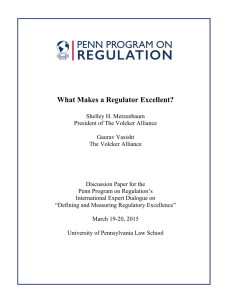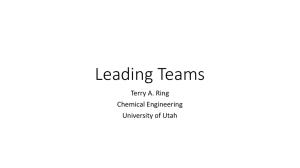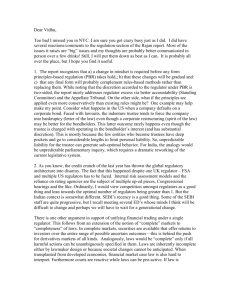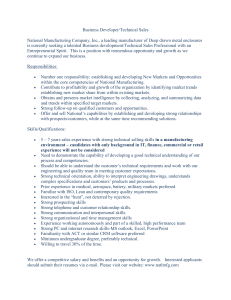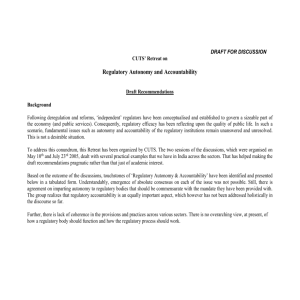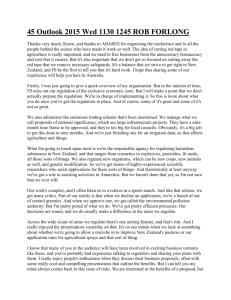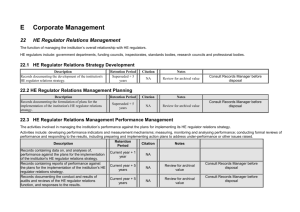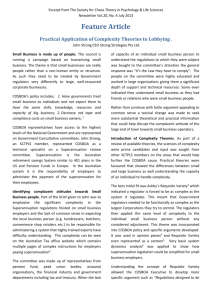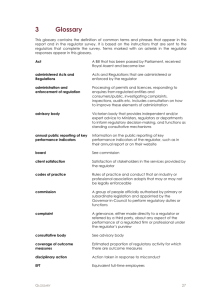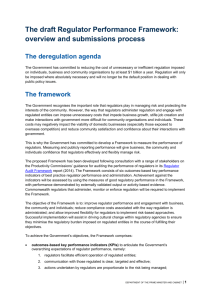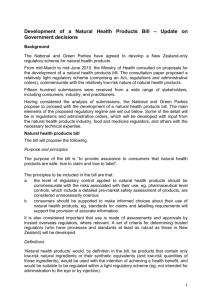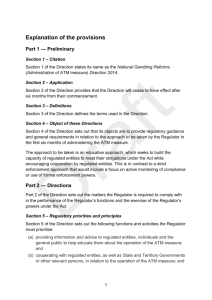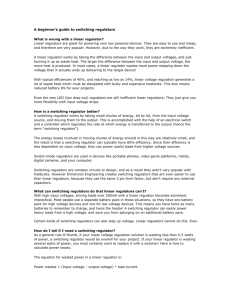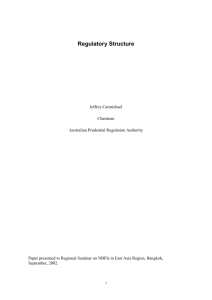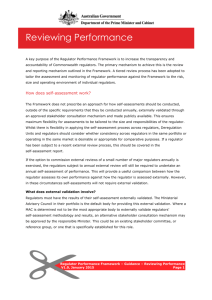Feb, 2015 Draft
advertisement
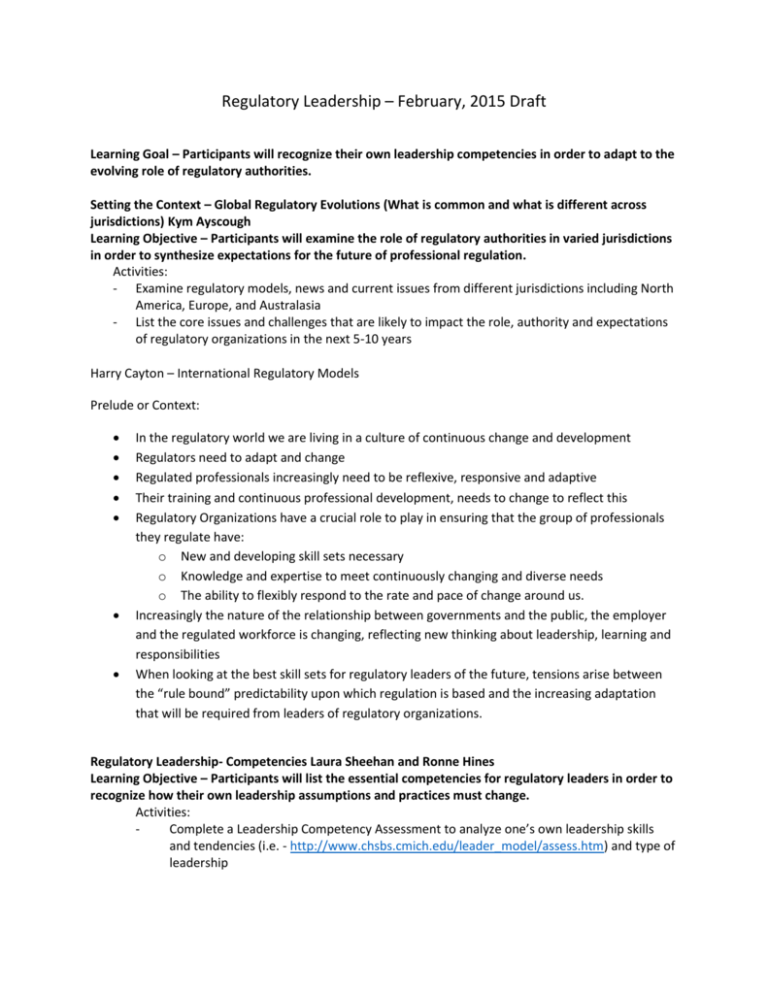
Regulatory Leadership – February, 2015 Draft Learning Goal – Participants will recognize their own leadership competencies in order to adapt to the evolving role of regulatory authorities. Setting the Context – Global Regulatory Evolutions (What is common and what is different across jurisdictions) Kym Ayscough Learning Objective – Participants will examine the role of regulatory authorities in varied jurisdictions in order to synthesize expectations for the future of professional regulation. Activities: - Examine regulatory models, news and current issues from different jurisdictions including North America, Europe, and Australasia - List the core issues and challenges that are likely to impact the role, authority and expectations of regulatory organizations in the next 5-10 years Harry Cayton – International Regulatory Models Prelude or Context: In the regulatory world we are living in a culture of continuous change and development Regulators need to adapt and change Regulated professionals increasingly need to be reflexive, responsive and adaptive Their training and continuous professional development, needs to change to reflect this Regulatory Organizations have a crucial role to play in ensuring that the group of professionals they regulate have: o New and developing skill sets necessary o Knowledge and expertise to meet continuously changing and diverse needs o The ability to flexibly respond to the rate and pace of change around us. Increasingly the nature of the relationship between governments and the public, the employer and the regulated workforce is changing, reflecting new thinking about leadership, learning and responsibilities When looking at the best skill sets for regulatory leaders of the future, tensions arise between the “rule bound” predictability upon which regulation is based and the increasing adaptation that will be required from leaders of regulatory organizations. Regulatory Leadership- Competencies Laura Sheehan and Ronne Hines Learning Objective – Participants will list the essential competencies for regulatory leaders in order to recognize how their own leadership assumptions and practices must change. Activities: Complete a Leadership Competency Assessment to analyze one’s own leadership skills and tendencies (i.e. - http://www.chsbs.cmich.edu/leader_model/assess.htm) and type of leadership - - Identify the “traditional” skill set of regulatory leaders (admin law, legislation, understanding regulation, rule-bound guidelines, the role of gov’t., etc.) Using the summary of future regulatory expectations, define the skills and competencies that will be essential to regulatory leaders (analyze data, vision, communication, courage, self reflection/self-care, etc.) Identify individual growth areas and tools to help prepare for the future of regulatory leadership Characteristics of Regulatory Agencies: Black and white application of rules Process over efficiencies Efforts and impact affected by budget and appropriations Characteristics of some of the ways Regulatory Organizations behave: The way we have always done things But what about the rules? Regulators shouldn't change too much - it's our job to be consistent and maintain professional standards Evolution of Regulatory Agencies: Finding efficiencies Educating consumers Increased Impact vs. maintenance of existing efforts The Evolution of Regulatory Organizations Remaining relevant Driving rather than responding to change Monitoring the “temperature” for climate change What are the ways regulatory leaders will need to change to remain relevant for professional practice? How can we adapt and change to think about regulation in a different way? Effective Regulator: Efficient Problem Solver Innovative Traditional Regulator Skill Sets: Understanding professional association roles in relation to regulation Understanding consumer needs About the work – in other words focused on process over outcomes generally o Traditionally, regulatory leaders have a desired skill set of: administrative law or legislation Understanding the professional uniqueness of the regulated profession Understanding the role of government in relation to the regulator and its mandate Using rule-bound guidelines such as legislative authority to guide practice Exercising its duty of care in a focused “rule-bound” format Using disciplined, consistent leadership, focused on a narrow set of rules to maintain a “sameness prescribed attitude “ toward decision-making and strategic directions Past vs. Future Performance and other metrics to determine impact Driving voice in policy and legislation to reflect regulatory role in anticipating needs of professions instead of reacting to change Developing ability to look forward by reflecting upon past work, real outcomes and needs for adjusting approaches to regulation, costs and impacts Past vs. Future Source: University of Ottawa/Carlton Centre for Public Policy and Management Developing the ability to evaluate evidence using quality data and reliable analytical tools, while recognizing and working within limitations frequently encountered; Encouraging agile and adaptive measures that can be readily adjusted to accommodate new knowledge and improve the precision of a regulation's effect; Promoting alignment with partners and international regulatory regimes; Using an open, dynamic and consultative process based on transparency and shared responsibility; Ensuring performance metrics are used that reveal the effect of a proposed regulation and/or its costs so that the regulation can be evaluated to determine its impact; Organizational Climate Leaders focus on meeting the needs of many constituencies Engage with leaders, employees and constituencies Task oriented leadership vs. relationship oriented leadership Future skills and competencies of regulator: Empowering others – also succession planning Compliance – fair, affordable, protects consumers while balancing the needs and impact of the profession on the local economy Responsible in development of regulation – become a driving voice that results in good policy and efficient regulation Plan for dealing with multi-constituencies for impact and effective regulation Be able to clarify change, determine need for change, and to communicate the need for change – be clear if needed, why implemented, analyze new methods of working, new relationships, new threats Managing Uncertainty – Organizationally, regulators try to reduce/manage out uncertainty. Holding it and allowing it to unfold is unfamiliar territory and requires new skills. How many people here feel accomplished at managing uncertainty? Empowering Others – Regulatory organizations thrive on multiple processes, checking on decision making, making sure that our public reputation isn’t affected. Empowering people is pretty low down on the list and maybe not on it at all. Does your organization currently empower, or does it control? How can you change this? Monitoring “climate” both internal and external. Noticing with intention recurring patterns of behavior, attitude and feelings that characterize the life cycle of your organization and its response as a regulator to public protection. Does your organization regularly take climate checks? Promoting compliance and enforcement that is open, fair, transparent and affordable Accessibility – it isn’t enough to ‘consult’, we need to have our door open to the views of others all the time and be pro-active in creating opportunities to listen to and understand the views of our stakeholders. Throughout this process we have built in opportunities for participative involvement so that the changes we are making are owned by the industry, and so they become part of the solution Reliability – this builds confidence because we do what we say we will do. If we are currently thought of as those people in that ivory tower who push bundles of papers around, who don’t communicate with us in language we understand, and who take forever to come to decisions, then that isn’t being reliable, that’s being rigid and distant. We are reviewing the regulatory model so that we remain relevant as well as reliable Flexibility – this doesn’t mean making ad hoc changes for the sake of expediency, but us making sure that our processes are continuously reviewed and refined to reflect the current context of practice. If we are flexible, then we cannot hide behind procedures and our ‘rules’ Creativity – we have a role in being creative, in grasping hold of the opportunities we have to influence policy, and to collaborate in developing solutions that will make the regulatory environment fit for purpose Courage – we need to be courageous in several ways. We need to be courageous in making regulatory decisions without being unduly influenced by stakeholders. We also need to be courageous in finding a new road for regulation which acknowledges the whole system with all its flaws, understands the contribution it makes to this system, doesn’t pretend to be perfect, works in partnership with the industry to ensure that regulation meets the needs of the regulated workforce to achieve public safety And before you start thinking that’s a tall order, it helps to understand this in stages of progress Emerging (demonstrating potential) Established (Consistent demonstration of good practice) Accomplished (providing a model to which others can aspire) We don’t start out as ‘accomplished’ in any of this! And we need to know it’s ok to fail So how can we do this? Leadership Behavior and Organizational Climate: An Empirical Study in a Non-profit Organization, Joseph B. Holloway, Regent University. http://www.regent.edu/acad/global/publications/elj/vol5iss1/ELJ_Vol5No1_Holloway_pp9-35.pdf Prospective Sources for Inclusion: Malcolm Sparrow (particularly related to his risk-based regulation insight and various models/tools that can be applied to different regulatory contexts) http://www.hks.harvard.edu/fs/msparrow/ Jane Sparrow (for insight relating to building a good organizational culture) http://www.theculturebuilders.com/ Conclusion: Consider how these specific competencies are likely to show up in each of the following modules.
